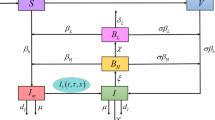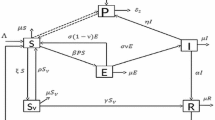Abstract
In this article, we propose a cholera model to study the effects of multiple transmission pathways, imperfect vaccine, nonlinear incidences, and differential infectivity of vibrios. The expression of the basic reproductive number \(\mathcal {R}_0\) is derived. There is only the disease-free equilibrium \(E_0\) if \(\mathcal {R}_0\le 1\), while, besides \(E_0\), there is also a unique endemic equilibrium \(E^*\) if \(\mathcal {R}_0>1\). When \(\mathcal {R}_0<1\), \(E_0\) is globally asymptotically stable by using the technique of linearization and the fluctuation lemma. When \(\mathcal {R}_0>1\), \(E^*\) is globally asymptotically stable by the Lyapunov direct method. These theoretical results are supported with numerical simulations for the case with Beddington-DeAngelis incidences. We further perform the sensitivity analyses of \(\mathcal {R}_0\) and the infection level at \(E^*\) to determine the significant parameters affecting disease outbreak and severity, respectively. Influences of the vaccination rate \(\phi \) and the waning rate of vaccine \(\eta \) on the dynamical behaviors of the model are also discussed.








Similar content being viewed by others
References
WHO: Report of World Health Organization, 2022, accessed 20 September 2022. https://www.who.int/news-room/fact-sheets/detail/cholera
Nelson, E.J., Harris, J.B., Morris, J.G., Calderwood, S.B., Camilli, A.: Cholera transmission: the host, pathogen and bacteriophage dynamic. Nat. Rev. Microbiol. 7(10), 693–702 (2009). https://doi.org/10.1038/nrmicro2204
Capasso, V., Paveri-Fontana, S.L.: A mathematical model for the 1973 cholera epidemic in the european mediterranean region. Rev. Epidemol. Sante Publique 27(2), 121–132 (1979)
Codeo, C.T.: Endemic and epidemic dynamics of cholera: the role of the aquatic reservoir. BMC Infect. Dis. 1(1), 1–14 (2001). https://doi.org/10.1186/1471-2334-1-1
Goh, K.T., Teo, S.H., Lam, S., Ling, M.K.: Person-to-person transmission of cholera in a psychiatric hospital. J. Infect. 20(3), 193–200 (1990). https://doi.org/10.1016/0163-4453(90)90994-J
Mukandavire, Z., Liao, S., Wang, J., Gaff, H., Smith, D.L., Morris, J.G., Jr.: Estimating the reproductive numbers for the 2008–2009 cholera outbreaks in zimbabwe. Proc. Natl. Acad. Sci. 108(21), 8767–8772 (2011). https://doi.org/10.1073/pnas.1019712108
Kumar Gupta, R., Kumar Rai, R., Kumar Tiwari, P., Kumar Misra, A., Martcheva, M.: A mathematical model for the impact of disinfectants on the control of bacterial diseases. J. Biol. Dyn. 17(1), 2206859 (2023). https://doi.org/10.1080/17513758.2023.2206859
Shuai, Z., van den Driessche, P.: Global dynamics of cholera models with differential infectivity. Math. Biosci. 234(2), 118–126 (2011). https://doi.org/10.1016/j.mbs.2011.09.003
Wang, J., Liao, S.: A generalized cholera model and epidemic-endemic analysis. J. Biol. Dyn. 6(2), 568–589 (2012). https://doi.org/10.1080/17513758.2012.658089
Wang, Y., Cao, J.: Global stability of general cholera models with nonlinear incidence and removal rates. J. Franklin Inst. 352(6), 2464–2485 (2015). https://doi.org/10.1016/j.jfranklin.2015.03.030
Song, C., Xu, R., Bai, N., Tian, X., Lin, J.: Global dynamics and optimal control of a cholera transmission model with vaccination strategy and multiple pathways. Math. Biosci. Eng. 17(4), 4210–4224 (2020). https://doi.org/10.3934/mbe.2020233
Bai, N., Song, C., Xu, R.: Mathematical analysis and application of a cholera transmission model with waning vaccine-induced immunity. Nonlinear Anal. Real World Appl. 58, 103232 (2021). https://doi.org/10.1016/j.nonrwa.2020.103232
Onuorah, M.O., Atiku, F.A., Juuko, H.: Mathematical model for prevention and control of cholera transmission in a variable population. Res. Math. (2022). https://doi.org/10.1080/27658449.2021.2018779
Tian, J.P., Jin, W.: Global stability for cholera epidemic models. Math. Biosci. 232(1), 31–41 (2011). https://doi.org/10.1016/j.mbs.2011.04.001
Wang, X., Chen, Y., Martcheva, M., Rong, L.: Asymptotic analysis of a vector-borne disease model with the age of infection. J. Biol. Dyn. 14(1), 332–367 (2020). https://doi.org/10.1080/17513758.2020.1745912
Li, B., Zhang, F., Wang, X.: A delayed diffusive hbv model with nonlinear incidence and ctl immune response. Math. Methods Appl. Sci. 45(17), 11930–11961 (2022). https://doi.org/10.1002/mma.8547
Wang, X., Zhang, Z., Jia, C.: A SEIARV model with asymptomatic infection and saturation rates. J. Xinyang Normal Univ. (Natl. Sci. Edn.) 36(01), 16–21 (2023). https://doi.org/10.3969/j.issn.1003-0972.2023.01.003
Korobeinikov, A.: Global properties of infectious disease models with nonlinear incidence. Bull. Math. Biol. 69(6), 1871–1886 (2007). https://doi.org/10.1007/s11538-007-9196-y
Ge, Q., Wang, X., Rong, L.: A delayed reaction-diffusion viral infection model with nonlinear incidences and cell-to-cell transmission. Int. J. Biomath. 14(8), 305–342 (2021). https://doi.org/10.1142/S179352452150100X
Hartley, D.M., Morris, J.G., Jr., Smith, D.L.: Hyperinfectivity: A critical element in the ability of v. cholerae to cause epidemics? PLoS Med. 3(1), 63–69 (2006). https://doi.org/10.1371/journal.pmed.0030007
Shuai, Z., Tien, J.H., van den Driessche, P.: Cholera models with hyperinfectivity and temporary immunity. Bull. Math. Biol. 74(10), 2423–2445 (2012). https://doi.org/10.1007/s11538-012-9759-4
WHO: Global Task Force on Cholera Control, Cholera Country Profile, 2011, accessed 20 September 2022. http://www.who.int/cholera/countries/Haiti Country Profile
Sharma, S., Singh, F.: Bifurcation and stability analysis of a cholera model with vaccination and saturated treatment. Chaos, Solitons & Fractals 146(6), 110912 (2021). https://doi.org/10.1016/j.chaos.2021.110912
Tian, X., Xu, R., Lin, J.: Mathematical analysis of a cholera infection model with vaccination strategy. Appl. Math. Comput. 361, 517–535 (2019). https://doi.org/10.1016/j.amc.2019.05.055
Cui, J., Wu, Z., Zhou, X.: Mathematical analysis of a cholera model with vaccination. J. Appl. Math. 13(2), 1–16 (2014). https://doi.org/10.1155/2014/324767
Khajanchi, S., Mondal, J., Tiwari, P.K.: Optimal treatment strategies using dendritic cell vaccination for a tumor model with parameter identifiability. J. Biol. Syst. 31(02), 487–516 (2023). https://doi.org/10.1142/S0218339023500171
van den Driessche, P., Watmough, J.: Reproduction numbers and sub-threshold endemic equilibria for compartmental models of disease transmission. Math. Biosci. 180(1), 29–48 (2002). https://doi.org/10.1016/S0025-5564(02)00108-6
Tineo, A.: Asymptotic behaviour of positive solutions of the nonautonomous lotka-volterra competition equations. Differ. Integr. Equ. 6(2), 449–457 (1993)
Yang, J., Bi, S.: Stability and hopf bifurcation of a delayed virus infection model with latently infected cells and beddington-deangelis incidence. Int. J. Biomath. 13(5), 2050045 (2020). https://doi.org/10.1142/S179352452050045X
Zhao, S.: Analysis on stochastic dynamics of two-consumers-one-resource competing systems with beddington-deangelis functional response. Int. J. Biomath. 14(2), 2050058 (2021). https://doi.org/10.1142/S1793524520500588
Modnak, C.: A model of cholera transmission with hyperinfectivity and its optimal vaccination control. Int. J. Biomath. 10(6), 1750084 (2017). https://doi.org/10.1142/S179352451750084X
Sanchez, M.A., Blower, S.M.: Uncertainty and sensitivity analysis of the basic reproductive rate: tuberculosis as an example. Am. J. Epidemiol. 145(12), 1127–1137 (1997). https://doi.org/10.1093/oxfordjournals.aje.a009076
Wang, Y., Zhou, Y., Brauer, F., Heffernan, J.M.: Viral dynamics model with ctl immune response incorporating antiretroviral therapy. J. Math. Biol. 67(4), 901–934 (2013). https://doi.org/10.1007/s00285-012-0580-3
Wang, S., Xu, F., Rong, L.: Bistability analysis of an hiv model with immune response. J. Biol. Syst. 25(4), 677–695 (2017). https://doi.org/10.1142/S021833901740006X
Wang, X., Chen, Y., Song, X.: Global dynamics of a cholera model with age structures and multiple transmission modes. Int. J. Biomath. 12(5), 1950051 (2019). https://doi.org/10.1142/S1793524519500517
Berge, T., Bowong, S., Lubuma, J.M.-S.: Global stability of a two-patch cholera model with fast and slow transmissions. Math. Comput. Simul. 133, 142–164 (2017). https://doi.org/10.1016/j.matcom.2015.10.013
Posny, D., Modnak, C., Wang, J.: A multigroup model for cholera dynamics and control. Int. J. Biomath. 9(1), 1–27 (2016). https://doi.org/10.1142/S1793524516500017
Robertson, S.L., Eisenberg, M.C., Tien, J.H.: Heterogeneity in multiple transmission pathways: modelling the spread of cholera and other waterborne disease in networks with a common water source. J. Biol. Dyn. 7(1), 254–275 (2013). https://doi.org/10.1080/17513758.2013.853844
Wang, F.-B., Wang, X.: A general multipatch cholera model in periodic environments. Discrete Contin. Dyn. Syst. 27(3), 1647–1670 (2022). https://doi.org/10.3934/dcdsb.2021105
Eisenberg, M.C., Shuai, Z., Tien, J.H., van den Driessche, P.: A cholera model in a patchy environment with water and human movement. Math. Biosci. 246(1), 105–112 (2013). https://doi.org/10.1016/j.mbs.2013.08.003
Brauer, F., Shuai, Z., van den Driessche, P.: Dynamics of an age-of-infection cholera model. Math. Biosci. Eng. 10(6), 1335–1349 (2013). https://doi.org/10.3934/mbe.2016.13.227
Lin, J., Xu, R., Tian, X.: Global dynamics of an age-structured cholera model with both human-to-human and environment-to-human transmissions and saturation incidence. Appl. Math. Model. 63, 688–708 (2018). https://doi.org/10.1016/j.apm.2018.07.013
Cai, L.-M., Modnak, C., Wang, J.: An age-structured model for cholera control with vaccination. Appl. Math. Comput. 299, 127–140 (2017). https://doi.org/10.1016/j.amc.2016.11.013
Kokomo, E., Emvudu, Y.: Mathematical analysis and numerical simulation of an age-structured model of cholera with vaccination and demographic movements. Nonlinear Anal. Real World Appl. 45, 142–156 (2019). https://doi.org/10.1016/j.cnsns.2018.06.023
Liu, W., Wang, J., Zhang, R.: Dynamics of an infection age-space structured cholera model with neumann boundary condition. Eur. J. Appl. Math. 33(3), 393–422 (2022). https://doi.org/10.1017/S095679252100005X
Yang, J., Modnak, C.: Dynamical analysis and optimal control simulation for an age-structured cholera transmission model. J. Franklin Inst. 356(15), 8438–8467 (2019). https://doi.org/10.1016/j.jfranklin.2019.08.016
Yang, J., Qiu, Z., Li, X.: Global stability of an age-structured cholera model. Math. Biosci. Eng. 11(3), 641–665 (2014). https://doi.org/10.3934/mbe.2014.11.641
Cai, L., Fan, G., Yang, C., Wang, J.: Modeling and analyzing cholera transmission dynamics with vaccination age. J. Franklin Inst. 357(12), 8008–8034 (2020). https://doi.org/10.1016/j.jfranklin.2020.05.030
Wang, X., Posny, D., Wang, J.: A reaction-convection-diffusion model for cholera spatial dynamics. Discrete Contin. Dyn. Syst. 21(8), 2785–2809 (2016). https://doi.org/10.3934/dcdsb.2016073
Capone, F., De Cataldis, V., De Luca, R.: Influence of diffusion on the stability of equilibria in a reaction-diffusion system modeling cholera dynamic. J. Math. Biol. 71(5), 1107–1131 (2015). https://doi.org/10.1007/s00285-014-0849-9
Misra, A., Gupta, A.: A reaction-diffusion model for the control of cholera epidemic. J. Biol. Syst. 24(4), 431–456 (2016). https://doi.org/10.1142/S0218339016500224
Shu, H., Ma, Z., Wang, X.-S.: Threshold dynamics of a nonlocal and delayed cholera model in a spatially heterogeneous environment. J. Math. Biol. 83(4), 1–33 (2021). https://doi.org/10.1007/s00285-021-01672-5
Wang, X., Zhao, X.-Q., Wang, J.: A cholera epidemic model in a spatiotemporally heterogeneous environment. J. Math. Anal. Appl. 468(2), 893–912 (2018). https://doi.org/10.1016/j.jmaa.2018.08.039
Tiwari, P.K., Rai, R.K., Khajanchi, S., Gupta, R.K., Misra, A.K.: Dynamics of coronavirus pandemic: effects of community awareness and global information campaigns. Eur. Phys. J. Plus 136(994), 11930–11961 (2021). https://doi.org/10.1140/epjp/s13360-021-01997-6
Acknowledgements
This work is supported partially by the National Natural Science Foundation of China (12171413), the Natural Science Foundation of Henan Province (222300420016), the Program for Science and Technology Innovation Teams in Henan (21IRTSTHN014), and the Natural Science Foundation of Hunan Province (2019JJ40027).
Author information
Authors and Affiliations
Contributions
HZ: Writing-original draft, Software. SZ: Writing-Reviewing and Editing. XW: Methodology, Supervision, Writing-Reviewing and Editing. YC: Supervision, Writing-Reviewing and Editing.
Corresponding author
Ethics declarations
Conflict of interest
The authors declare that they have no known competing financial interests or personal relationships that could have appeared to influence the work reported in this paper.
Additional information
Publisher's Note
Springer Nature remains neutral with regard to jurisdictional claims in published maps and institutional affiliations.
Rights and permissions
Springer Nature or its licensor (e.g. a society or other partner) holds exclusive rights to this article under a publishing agreement with the author(s) or other rightsholder(s); author self-archiving of the accepted manuscript version of this article is solely governed by the terms of such publishing agreement and applicable law.
About this article
Cite this article
Zhao, H., Zou, S., Wang, X. et al. Dynamic behaviors of a cholera model with nonlinear incidences, multiple transmission pathways, and imperfect vaccine. J. Appl. Math. Comput. 70, 917–946 (2024). https://doi.org/10.1007/s12190-024-01994-9
Received:
Revised:
Accepted:
Published:
Issue Date:
DOI: https://doi.org/10.1007/s12190-024-01994-9




